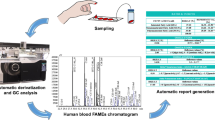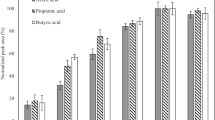Abstract
Large population studies show that polyunsaturated fatty acids are important for human health, but determining relationships between the health benefits and the fatty acid content has been hampered by the unavailability of labor-effective high-throughput technologies. An automated high throughput fatty acid analysis was developed from a previous procedure based on direct transesterification including the automation of chemical procedures, data acquisition and automatic data processing. The method was validated and applied to umbilical cord serum samples in an epidemiological study. The method was linear in the range of 1–600 μg/mL serum with r 2 ≥0.99. The within-run CV was <5.4% for 23 fatty acids and a range of recoveries over three concentrations were 76–119% in a low-lipid matrix with the exception of 14:0. The fatty acid concentration as measured by the robotic method for human plasma was in good agreement with the Lepage & Roy method. The fatty acid profile in umbilical cord serum from American subjects (n = 287) showed an average of 38.0, 24.9, 32.0 and 4.6% of total fatty acids for saturates, monounsaturates, n-6 and n-3 polyunsaturates, respectively. This is the first report of a complete, validated, cost-effective, automated, high throughput fatty acid measurement method along with application to a population-based study. Automated fatty acid analysis coupled with automated data processing greatly facilitates the high throughput, 72 samples transesterified in 6 h, required for large population-based studies.




Similar content being viewed by others
Abbreviations
- AA:
-
Arachidonic acid
- DHA:
-
Docosahexaenoic acid
- EFA:
-
Essential fatty acid
- FAME:
-
Fatty acid methyl ester
- GC or GC/FID:
-
Gas chromatography/flame ionization detector
- GC/MS:
-
Gas chromatography/mass spectrometry
- HUFA:
-
Highly unsaturated fatty acid
- ISTD:
-
Internal standard
- LiHa:
-
Liquid handling arm
- pLLD:
-
Pressure-based liquid level detection
- PMP:
-
Pressure monitored pipetting
- PUFA:
-
Polyunsaturated fatty acid
- Robot:
-
Automated liquid handling system
- VBA:
-
Visual Basic Application
References
Bakker EC, Ghys AJ, Kester AD, Vles JS, Dubas JS, Blanco CE, Hornstra G (2003) Long-chain polyunsaturated fatty acids at birth and cognitive function at 7 y of age. Eur J Clin Nutr 57:89–95
Hibbeln JR, Davis JM, Steer C, Emmett P, Rogers I, Williams C, Golding J (2007) Maternal seafood consumption in pregnancy and neurodevelopmental outcomes in childhood (ALSPAC study): an observational cohort study. Lancet 369:578–585
Marchioli R, Barzi F, Bomba E, Chieffo C, Di GD, Di MR, Franzosi MG, Geraci E, Levantesi G, Maggioni AP, Mantini L, Marfisi RM, Mastrogiuseppe G, Mininni N, Nicolosi GL, Santini M, Schweiger C, Tavazzi L, Tognoni G, Tucci C, Valagussa F (2002) Early protection against sudden death by n-3 polyunsaturated fatty acids after myocardial infarction: time-course analysis of the results of the Gruppo Italiano per lo Studio della Sopravvivenza nell’Infarto Miocardico (GISSI)-Prevenzione. Circulation 105:1897–1903
Mihrshahi S, Peat JK, Webb K, Tovey ER, Marks GB, Mellis CM, Leeder SR (2001) The childhood asthma prevention study (CAPS): design and research protocol of a randomized trial for the primary prevention of asthma. Control Clin Trials 22:333–354
Seddon JM, George S, Rosner B (2006) Cigarette smoking, fish consumption, omega-3 fatty acid intake, and associations with age-related macular degeneration: the US Twin Study of Age-Related Macular Degeneration. Arch Ophthalmol 124:995–1001
Smithers LG, Collins CT, Simmonds LA, Gibson RA, McPhee A, Makrides M (2010) Feeding preterm infants milk with a higher dose of docosahexaenoic acid than that used in current practice does not influence language or behavior in early childhood: a follow-up study of a randomized controlled trial. Am J Clin Nutr 91:628–634
Salem N Jr, Kim HY, Yergy JA (1986) Docosahexaenoic acid: membrane function and metabolism. In: Simopoulos AP, Kifer RR, Martin RE (eds) Health effects of polyunsaturated fatty acids in seafoods. Academic Press, New York, pp 263–317
Mozaffarian D (2008) Fish and n-3 fatty acids for the prevention of fatal coronary heart disease and sudden cardiac death. Am J Clin Nutr 87:1991S–1996S
Calon F, Lim GP, Morihara T, Yang F, Ubeda O, Salem N Jr, Frautschy SA, Cole GM (2005) Dietary n-3 polyunsaturated fatty acid depletion activates caspases and decreases NMDA receptors in the brain of a transgenic mouse model of Alzheimer’s disease. Eur J Neurosci 22:617–626
Hibbeln JR, Salem N Jr (1995) Dietary polyunsaturated fatty acids and depression: when cholesterol does not satisfy. Am J Clin Nutr 62:1–9
Dunstan JA, Mori TA, Barden A, Beilin LJ, Taylor AL, Holt PG, Prescott SL (2003) Fish oil supplementation in pregnancy modifies neonatal allergen-specific immune responses and clinical outcomes in infants at high risk of atopy: a randomized, controlled trial. J Allergy Clin Immunol 112:1178–1184
Godwin SL, Chambers E, Cleveland L (2004) Accuracy of reporting dietary intake using various portion-size aids in-person and via telephone. J Am Diet Assoc 104:585–594
Marangoni F, Colombo C, Galli C (2004) A method for the direct evaluation of the fatty acid status in a drop of blood from a fingertip in humans: applicability to nutritional and epidemiological studies. Anal Biochem 326:267–272
Armstrong JM, Metherel AH, Stark KD (2008) Direct microwave transesterification of fingertip prick blood samples for fatty acid determinations. Lipids 43:187–196
Banerjee P, Dawson G, Dasgupta A (1992) Enrichment of saturated fatty acid containing phospholipids in sheep brain serotonin receptor preparations: use of microwave irradiation for rapid transesterification of phospholipids. Biochim Biophys Acta 1110:65–74
Glaser C, Demmelmair H, Koletzko B (2010) High-throughput analysis of fatty acid composition of plasma glycerophospholipids. J Lipid Res 51:216–221
Masood A, Stark KD, Salem N Jr (2005) A simplified and efficient method for the analysis of fatty acid methyl esters suitable for large clinical studies. J Lipid Res 46:2299–2305
Masood MA, Salem N Jr (2008) High-throughput analysis of plasma fatty acid methyl esters employing robotic transesterification and fast gas chromatography. Lipids 43:171–180
Blix G (1941) Electrophoresis of lipid-free blood serum. J Biol Chem 137:495–501
Folch J, Lees M, Sloane Stanley GH (1957) A simple method for the isolation and purification of total lipids from animal tissues. J Biol Chem 226:497–509
Lepage G, Roy CC (1986) Direct transesterification of all classes of lipids in a one-step reaction. J Lipid Res 27:114–120
US Food and Drug Administration Guidance for Industry. In: Bioanalytical method validation. http://www.fda.gov/downloads/Drugs/GuidanceComplianceRegulatoryInformation/Guidances/UCM070107.pdf. Accessed January 2012
US Department of Health and Human Services (1992) Medicare, Medicaid and CLIA programs; regulations implementing the Clinical Laboratory Improvement Amendments of 1988 (CLIA)–HCFA. Final rule with comment period. Fed Regist 57:7002–7186
Apelberg BJ, Goldman LR, Calafat AM, Herbstman JB, Kuklenyik Z, Heidler J, Needham LL, Halden RU, Witter FR (2007) Determinants of fetal exposure to polyfluoroalkyl compounds in Baltimore, Maryland. Environ Sci Technol 41:3891–3897
Glaser C, Demmelmair H, Koletzko B (2010) High-throughput analysis of total plasma fatty acid composition with direct in situ transesterification. PLoS One 5:e12045
Quehenberger O, Armando AM, Dennis EA (2011) High sensitivity quantitative lipidomics analysis of fatty acids in biological samples by gas chromatography-mass spectrometry. Biochim Biophys Acta 1811:648–656
Gil-Sanchez A, Larque E, Demmelmair H, Acien MI, Faber FL, Parrilla JJ, Koletzko B (2010) Maternal-fetal in vivo transfer of [13C] docosahexaenoic and other fatty acids across the human placenta 12 h after maternal oral intake. Am J Clin Nutr 92:115–122
Lewis RM, Hanson MA, Burdge GC (2011) Umbilical venous-arterial plasma composition differences suggest differential incorporation of fatty acids in NEFA and cholesteryl ester pools. Br J Nutr 106:463–467
Denkins YM, Woods J, Whitty JE, Hannigan JH, Martier SS, Sokol RJ, Salem N Jr (2000) Effects of gestational alcohol exposure on the fatty acid composition of umbilical cord serum in humans. Am J Clin Nutr 71:300S–306S
Donahue SM, Rifas-Shiman SL, Olsen SF, Gold DR, Gillman MW, Oken E (2009) Associations of maternal prenatal dietary intake of n-3 and n-6 fatty acids with maternal and umbilical cord blood levels. Prostaglandins Leukot Essent Fatty Acids 80:289–296
Kohlboeck G, Glaser C, Tiesler C, Demmelmair H, Standl M, Romanos M, Koletzko B, Lehmann I, Heinrich J (2011) Effect of fatty acid status in cord blood serum on children’s behavioral difficulties at 10 y of age: results from the LISAplus Study. Am J Clin Nutr 94:1592–1599
Pankiewicz E, Cretti A, Ronin-Walknowska E, Czeszynska MB, Konefal H, Hnatyszyn G (2007) Maternal adipose tissue, maternal and cord blood essential fatty acids and their long-chain polyunsaturated derivatives composition after elective caesarean section. Early Hum Dev 83:459–464
Lewis MD, Hibbeln JR, Johnson JE, Lin YH, Hyun DY, Loewke JD (2011) Suicide deaths of active-duty US military and omega-3 fatty-acid status: a case–control comparison. J Clin Psychiatry 72:1585–1590
Steer CD, Hibbeln JR, Golding J, Smith GD (2012) Polyunsaturated fatty acid levels in blood during pregnancy, at birth and at 7 years: their associations with two common FADS2 polymorphisms. Hum Mol Genet (in press)
Acknowledgments
This research was supported, in part, by the Intramural Research Program of the National Institute on Alcohol Abuse and Alcoholism, National Institutes of Health; and the National Oceanic and Atmospheric Administration. Thanks to Dr. Shui-Lin Niu for helping with the preparation of the low lipid serum, and Mr. Brian Brown for his assistance with manuscript editing.
Conflict of interest
The authors declare that there are no conflicts of interest.
Author information
Authors and Affiliations
Corresponding author
Electronic supplementary material
Below is the link to the electronic supplementary material.
About this article
Cite this article
Lin, Y.H., Salem, N., Wells, E.M. et al. Automated High-Throughput Fatty Acid Analysis of Umbilical Cord Serum and Application to an Epidemiological Study. Lipids 47, 527–539 (2012). https://doi.org/10.1007/s11745-012-3661-6
Received:
Accepted:
Published:
Issue Date:
DOI: https://doi.org/10.1007/s11745-012-3661-6




